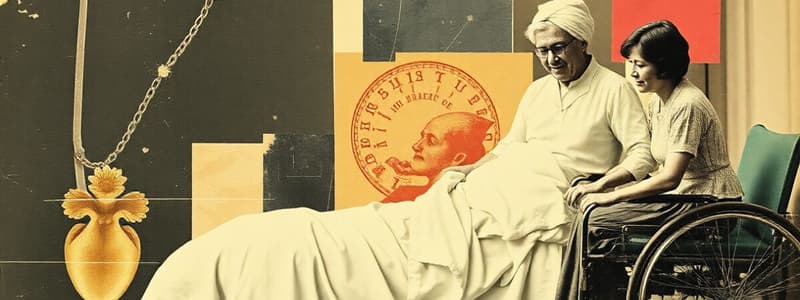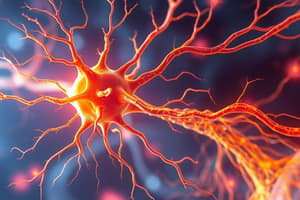Podcast
Questions and Answers
What should be assessed to monitor for the development of thrombophlebitis in immobile patients?
What should be assessed to monitor for the development of thrombophlebitis in immobile patients?
- Arterial blood flow to the extremities
- Peripheral pulse strength in the feet
- Skin turgor of the patient's abdomen
- Circumference of the calves and thighs (correct)
When encouraging self-care in patients who have had a stroke, which factor should be determined first?
When encouraging self-care in patients who have had a stroke, which factor should be determined first?
- The patient's dominant hand before the stroke (correct)
- The patient's level of motivation
- The patient's dietary preferences
- The patient's mobility status post-stroke
Which nursing intervention is recommended for promoting self-care in a stroke patient?
Which nursing intervention is recommended for promoting self-care in a stroke patient?
- Encouraging complete dependence on caregivers
- Limiting all activities to enhance safety
- Promoting use of the affected arm for independence
- Using the unaffected arm for activities of daily living (correct)
What role does collaboration with the occupational therapist play in the care of stroke patients?
What role does collaboration with the occupational therapist play in the care of stroke patients?
What technique should be used to help a stroke patient dress independently?
What technique should be used to help a stroke patient dress independently?
Which complication is particularly associated with immobility in stroke patients?
Which complication is particularly associated with immobility in stroke patients?
Why is it important to follow a regular schedule for daily routines in stroke rehabilitation?
Why is it important to follow a regular schedule for daily routines in stroke rehabilitation?
What should be reported promptly regarding manifestations of thrombophlebitis?
What should be reported promptly regarding manifestations of thrombophlebitis?
What is the primary goal of encouraging active range of motion (ROM) exercises in patients with stroke?
What is the primary goal of encouraging active range of motion (ROM) exercises in patients with stroke?
Which intervention is essential when performing passive range of motion exercises?
Which intervention is essential when performing passive range of motion exercises?
What is a recommended positioning strategy to prevent deformity in patients with hemiplegia?
What is a recommended positioning strategy to prevent deformity in patients with hemiplegia?
What is the recommended frequency for turning a patient to prevent complications from immobility?
What is the recommended frequency for turning a patient to prevent complications from immobility?
Why is it important to elevate the head of the bed (HOB) when the patient is supine?
Why is it important to elevate the head of the bed (HOB) when the patient is supine?
Which of these statements about passive range of motion (ROM) exercises is correct?
Which of these statements about passive range of motion (ROM) exercises is correct?
What can be a consequence of inadequate positioning in a patient with hemiplegia?
What can be a consequence of inadequate positioning in a patient with hemiplegia?
Which of these positions is recommended for a patient who is lying supine to avoid hip external rotation?
Which of these positions is recommended for a patient who is lying supine to avoid hip external rotation?
Flashcards are hidden until you start studying
Study Notes
Physical Mobility Post-Stroke
- Stroke can impact functional ability due to motor function impairments
- Nurses aim to maintain normal function, reduce spasticity, prevent edema and complications
- Active ROM exercises for unaffected extremities, help with affected ones
- Maintain/improve muscle strength and endurance
- Help maintain cardiopulmonary function
- Passive ROM exercises maintain joint flexibility, but don't strengthen muscles
- Turning every 2 hours
- Side-to-side and supine-to-prone position changes (verify prone positioning with HCP)
- Ensure proper body alignment and extremity support
- Elevate HOB 30 degrees when supine
- Maintains joint function, decreases dependent edema, alleviates pressure, and reduces complications
- Assess for thrombophlebitis
- Immobility increases risk
- Measure calf and thigh circumference, watch for warmth and redness
- Promptly report any manifestations
- Collaborate with physical therapist
- Consistent techniques for moving patient from bed to wheelchair
- Help with ambulation
- Facilitates rehabilitation
- Speech and language therapist
- Assess swallowing for safe intake
Promoting Self-Care Post-Stroke
- Stroke can cause self-care deficits due to confusion or mobility impairments
- Encourage self-care to promote function, decrease powerlessness, increase independence, and improve self-esteem
- Consider dominant hand before planning
- Promote use of unaffected arm
- ADLs: bathing, brushing teeth, combing hair, dressing, eating
- Teach dressing technique
- Affected extremities first, then unaffected
- Facilitates self-dressing
- Collaborate with occupational therapist
- Promote upper-extremity function for ADLs
- Encourage assistive devices
- Eating, dressing, physical hygiene
- Encourage regular schedule
- Promotes learning and positive self-concept
Studying That Suits You
Use AI to generate personalized quizzes and flashcards to suit your learning preferences.




